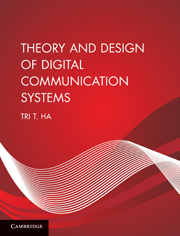Book contents
- Frontmatter
- Contents
- Preface
- Acknowledgements
- List of symbols
- List of abbreviations
- 1 Introduction
- 2 Deterministic signal analysis
- 3 Random signal analysis
- 4 Information theory and channel coding
- 5 Communication link analysis
- 6 Modulation
- 7 Demodulation
- 8 Spread spectrum
- 9 Intersymbol interference and equalization
- 10 Fading channels
- Index
- References
2 - Deterministic signal analysis
Published online by Cambridge University Press: 05 June 2012
- Frontmatter
- Contents
- Preface
- Acknowledgements
- List of symbols
- List of abbreviations
- 1 Introduction
- 2 Deterministic signal analysis
- 3 Random signal analysis
- 4 Information theory and channel coding
- 5 Communication link analysis
- 6 Modulation
- 7 Demodulation
- 8 Spread spectrum
- 9 Intersymbol interference and equalization
- 10 Fading channels
- Index
- References
Summary
Introduction
In this chapter we lay the foundation for the analysis and design of communication systems, and digital communication systems in particular. We employ deterministic signals to carry information from the transmitter to the receiver. These deterministic signals contain certain a priori features sufficiently adequate for the receiver to retrieve the information. Note that the information always appears random to the receiver, that is, it does not know which data it will receive; otherwise, communications would not be needed. Deterministic signals form a very broad class of signals; therefore, the first step is to categorize them so that their characterization can be fully exploited. The categorization leads to the labels continuous-time, discrete-time, periodic, aperiodic, analog, digital, energy, and power signals. Further study leads us to orthogonal signals and the use of signal space to represent digital signals as vectors. We also review linear time-invariant (LTI) systems and the important convolution operation that relates the inputs and outputs of an LTI system.
We then investigate Fourier series representation of continuous-time periodic signals, and Fourier transform of continuous-time aperiodic signals. The Fourier transform is indispensable in the analysis and design of LTI systems. The energy spectral density of an energy signal and the power spectral density of a power signal are studied. From here the autocorrelation functions of both energy and power signals are examined.
Information
- Type
- Chapter
- Information
- Theory and Design of Digital Communication Systems , pp. 10 - 77Publisher: Cambridge University PressPrint publication year: 2010
